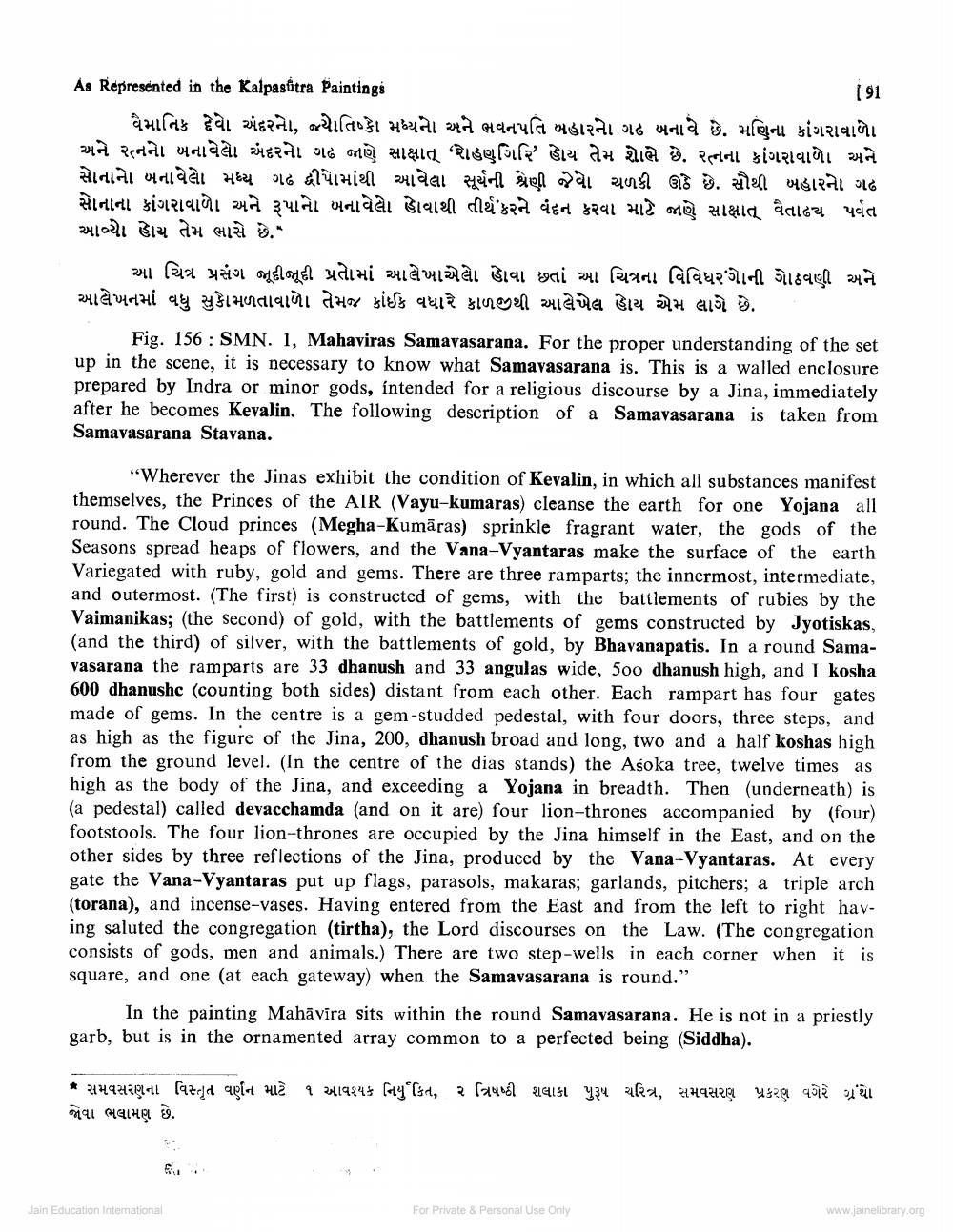________________
As Represented in the Kalpaslitra Paintings
[91
વૈમાનિક થા અંદરનો, જ્યાતિષ્ઠા મધ્યના અને ભવનપતિ બહારના ગઢ બનાવે છે, મધ્યના કાંગરાવાળા અને રત્નના બનાવેલા અંદરના ગઢ જાણે સાક્ષાત્ રાહગિરિ' હોય તેમ શાભે છે, રત્નના કાંગરાવાળેા અને સાનાના બનાવેલા મધ્યગઢ દ્વીામાંથી આવેલા સૂર્યની શ્રેણી જેવા ચળકી ઊઠે છે. સૌથી ખહારના ગઢ સોનાના કાંગરાવાળા અને રૂપાના બનાવેલો હોવાથી તીર્થંકરને વંદન કરવા માટે જાણે સાક્ષાત્ ચૈતાદ્રષ પર્વત આવ્યેા હોય તેમ ભાસે છે.
આ ચિત્ર પ્રસંગ તીરી પ્રતામાં આલેખાએલા યા હતાં આ ચિત્રના વિવિધરવાની ગોઠવણી અને આલેખનમાં વધુ સુકોમળતાવાળા તેમજ કાંઈક વધારે કાળજીથી આલેખેલ હોય એમ લાગે છે.
Fig. 156 SMN. 1, Mahaviras Samavasarana. For the proper understanding of the set up in the scene, it is necessary to know what Samavasarana is. This is a walled enclosure prepared by Indra or minor gods, intended for a religious discourse by a Jina, immediately after he becomes Kevalin. The following description of a Samavasarana is taken from Samavasarana Stavana.
"Wherever the Jinas exhibit the condition of Kevalin, in which all substances manifest themselves, the Princes of the AIR (Vayu-kumaras) cleanse the earth for one Yojana all round. The Cloud princes (Megha-Kumāras) sprinkle fragrant water, the gods of the Seasons spread heaps of flowers, and the Vana-Vyantaras make the surface of the earth. Variegated with ruby, gold and gems. There are three ramparts; the innermost, intermediate, and outermost. (The first) is constructed of gems, with the battlements of rubies by the Vaimanikas; (the second) of gold, with the battlements of gems constructed by Jyotiskas, (and the third) of silver, with the battlements of gold, by Bhavanapatis. In a round Samavasarana the ramparts are 33 dhanush and 33 angulas wide, 500 dhanush high, and I kosha 600 dhanushe (counting both sides) distant from each other. Each rampart has four gates made of gems. In the centre is a gem-studded pedestal, with four doors, three steps, and as high as the figure of the Jina, 200, dhanush broad and long, two and a half koshas high from the ground level. (In the centre of the dias stands) the Asoka tree, twelve times as high as the body of the Jina, and exceeding a Yojana in breadth. Then (underneath) is (a pedestal) called devacchamda (and on it are) four lion-thrones accompanied by (four) footstools. The four lion-thrones are occupied by the Jina himself in the East, and on the other sides by three reflections of the Jina, produced by the Vana-Vyantaras. At every gate the Vana-Vyantaras put up flags, parasols, makaras; garlands, pitchers; a triple arch (torana), and incense-vases. Having entered from the East and from the left to right hav ing saluted the congregation (tirtha), the Lord discourses on the Law. (The congregation consists of gods, men and animals.) There are two step-wells in each corner when it is square, and one (at each gateway) when the Samavasarana is round."
In the painting Mahavira sits within the round Samavasarana. He is not in a priestly. garb, but is in the ornamented array common to a perfected being (Siddha).
સમવસરણના વિસ્તૃત વર્ણન માટે ૧ આવશ્યક નિયુકિત, ૨ ત્રિષષ્ઠી શલાકા પુરૂષ ચરિત્ર, સમવસરણ પ્રકરણ વગેરે ગ્રંથો જોવા ભલામણ છે.
Jain Education International
For Private & Personal Use Only
www.jainelibrary.org




